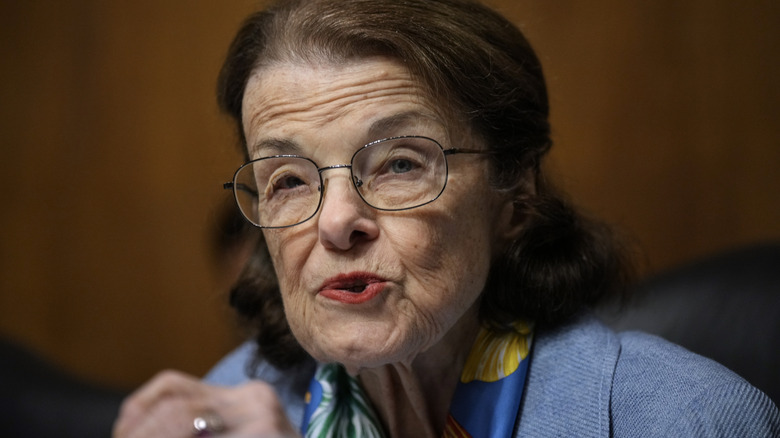What Happens If A Member Of Congress Dies While In Office?
As the Congressional Institute explains, whenever a senator dies in office, a series of steps are taken to honor the person's life, finalize unfinished congressional business related to their duties, and find a replacement so government work can continue. Though that process varies, that duty is most often left up to the governor of the senator's state. Meanwhile, other steps along the way are mandated by law, while some are matters of tradition.
As required by federal law, the most common means by which Congress honors someone who has died is to fly flags at half-mast for the day of and the day after a senator dies, but also sometimes until their funeral. The next steps look somewhat different between the House and Senate, depending on who has died. Based on precedent, the U.S. Senate will likely draft a simple declaration in honor of the deceased, and the Sergeant of Arms may also plan their funeral service. Words of respect and memorial may be said on the floor about the deceased, depending on the timing of the death.
Several senators and congress members have been laid in state in the United States Capitol rotunda. The last Congressman to lie in state after his death was Donald E. Young of Alaska in March 2022, according to Architect of the Capitol, with Sen. Henry Reid of Nevada preceding him in that honor in January of the same year. There is no hard protocol for which senators lie in state in the Capitol, rather, families can make the request and Congress must approve it.
Vacant seats and the 17th amendment
When a senate seat is vacated for any reason — including, but not limited, to death — perhaps the most pressing matter of all is to appoint a replacement for the vacated seat, as mandated by the Senate Committee on Rules and Administration. Prior to the 17th Amendment of the U.S. Constitution, state legislators appointed successors. But with the ratification of the 17th amendment in 1913, state governors were put in charge. However, this, too, happens differently depending on the state.
In 46 states a sitting governor can appoint someone to fill the senate seat — at least temporarily — per Pew Research. In many states, the appointed person may choose to run for office in the next election cycle. In a few states, the seat sits empty until a special election is held, and even where an interim senator is appointed by a governor, special elections will likely be held to replace that person depending on the timing left in the term. Vacant House seats are always ultimately filled by a special election, but the timing on those varies from state to state based on myriad factors.
California's Feinstein timeline
With the 2023 death of 90-year-old California Senator Dianne Feinstein, all eyes were on California to determine who her successor might be. Feinstein's term was slated to end in 2025, and before she died she said she would not run again, meaning California would choose a new Senator at a general election in November 2024, anyway.
California Governor Gavin Newsom appointed an interim senator just days after Feinstein's death, choosing 44-year-old Laphonza Butler, who is not a politician but has long been a leader in the political arena, per the University of California. Politico reports that most likely a special election to choose who will serve the rest of Feinstein's term will be held at the same time as the upcoming primary election in March 2024. Following that, in November 2024 Californians would vote all over again in the general election, meaning Newsom's temporary pick could win each time, and then serve a full term beginning in 2025.
Newsom said he'd appoint a Black woman to fill Feinstein's seat on an interim basis, and he made good on his promise. While California state Representative Barbara Lee was floated as another possibility, she along with Representatives Adam Schiff and Katie Porter had already announced their intention to run for Feinstein's seat in the general election, yet Newsome opted for someone who has yet to serve in office.


